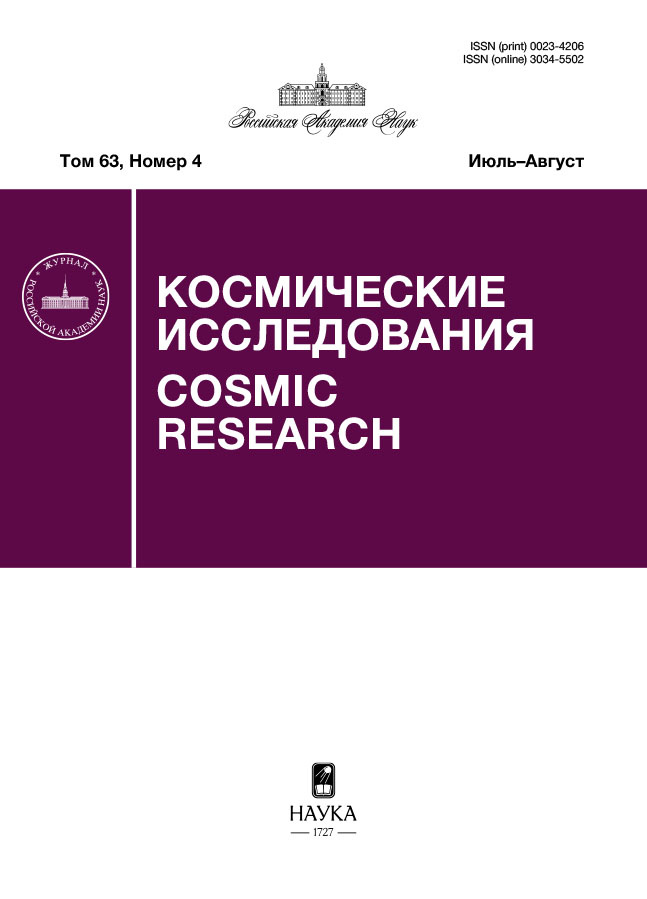Моделирование радиационной обстановки на земле во время солнечных протонных событий в процессе геомагнитной инверсии
- Авторы: Левашов Н.Н.1, Царева О.О.1, Попов В.Ю.1,2,3, Малова Х.В.1,2, Зеленый Л.М.1
-
Учреждения:
- Институт космических исследований РАН
- МГУ имени М.В. Ломоносова
- Национальный исследовательский университет «Высшая школа экономики»
- Выпуск: Том 63, № 1 (2025)
- Страницы: 71-78
- Раздел: Статьи
- URL: https://ter-arkhiv.ru/0023-4206/article/view/682927
- DOI: https://doi.org/10.31857/S0023420625010072
- EDN: https://elibrary.ru/HEAUSV
- ID: 682927
Цитировать
Полный текст
Аннотация
Исследуется радиационная опасность на Земле от галактических и солнечных космических лучей при прохождении их через современную и разреженную (в результате множественных инверсий) атмосферу во время солнечных протонных событий и в момент геомагнитной инверсии. Полагается, что в процессе инверсии геомагнитное поле ослабевает и принимает осесимметричную квадрупольную конфигурацию. Показано, что в случае однократной инверсии, когда атмосфера не успевает измениться, мощности доз радиации увеличиваются только на низких широтах и идентичны современному радиационному уровню у полюсов. Однако, в период множественных инверсий, когда атмосфера разрежена, уровень радиации в момент инверсии на поверхности Земли повышается, в среднем, в два раза, по сравнению с современным уровнем на всех широтах, что может влиять на биосферу.
Полный текст
Об авторах
Н. Н. Левашов
Институт космических исследований РАН
Автор, ответственный за переписку.
Email: nn.levashov@physics.msu.ru
Россия, Москва
О. О. Царева
Институт космических исследований РАН
Email: nn.levashov@physics.msu.ru
Россия, Москва
В. Ю. Попов
Институт космических исследований РАН; МГУ имени М.В. Ломоносова; Национальный исследовательский университет «Высшая школа экономики»
Email: nn.levashov@physics.msu.ru
Физический факультет
Россия, Москва; Москва; МоскваХ. В. Малова
Институт космических исследований РАН; МГУ имени М.В. Ломоносова
Email: nn.levashov@physics.msu.ru
Научно-исследовательский институт ядерной физики им. Д.В. Скобельцына
Россия, Москва; МоскваЛ. М. Зеленый
Институт космических исследований РАН
Email: nn.levashov@physics.msu.ru
Россия, Москва
Список литературы
- Маурчев Е.А., Балабин Ю.В., Германенко А.В. и др. Влияние протонов космических лучей на образование вторичных частиц и ионизацию в атмосфере Земли // Труды Кольского научного центра РАН. 2019. Т. 10. № 8(5). С. 240–249. https://doi.org/10.25702/KSC.2307-5252.2019.10.8.240-249
- Snyder C.W., Neugebauer M., Rao U.R. The solar wind velocity and its correlation with cosmic ray variations and with solar and geomagnetic activity // J. Geophys Res. 1963. V. 68. Iss. 34. P. 6361–6370. https://doi.org/10.1029/JZ068i024p06361
- Криволуцкий А.А., Репнев А.И. Воздействие космических энергичных частиц на атмосферу земли (обзор) // Геомагнетизм и аэрономия. 2012. Т. 52. № 6. С. 723–754.
- Dehant V., Lammer H., Kulikov Y.N. et al. Planetary Magnetic Dynamo Effect on Atmospheric Protection of Early Earth and Mars // Space Science Reviews. 2007. V. 129(1–3). P. 279–300. https://doi.org/10.1007/s11214-007-9163-9
- Wei Y., Pu Z., Zong Q.-W. et al. Oxygen escape from the Earth during geomagnetic reversals: Implications to mass extinction // Earth and Planetary Science Letters. 2014.V. 394. P. 94–98. https://doi.org/10.1016/j.epsl.2014.03.018
- Царёва О.О., Зелёный Л.М., Малова Х.В. и др. Что ожидает человечество при инверсии магнитного поля Земли: угрозы мнимые и подлинные // Успехи физических наук. 2018. № 188. С. 207–220. https://doi.org/10.3367/UFNr.2017.07.038190
- Laurenza M., Consolini G., Storini M. et al. The Weibull functional form for SEP event spectra // J. Physics Conference Series. 2015. V. 632. Art.ID012066. https://doi.org/10.1088/1742-6596/632/1/012066
- Agostinelli S., Allisonas J., Amako K. et al. Geant4 – A Simulation Toolkit // Nuclear Instruments and Methods in Physics Research. 2003. V. 506. P. 250–303. https://doi.org/10.1016/S0168-9002(03)01368-8
- Allison J., Amako K., Apostolakis J. et al. Recent developments in geant4 // Nuclear Instruments and Methods in Physics Research. Section A. 2016. V. 835. P. 186–225. https://doi.org/10.1016/j.nima.2016.06.125
- Picone J., Hedin A.E., Drob D. et al. NRLMSISE-00 empirical model of the atmosphere: Statistical comparison and scientific issues // J. Geophysical Research. 2002. V. 107. Iss. A12. Art.ID. 1468. https://doi.org/10.1029/2002JA009430
- Störmer C. The polar Aurora. Oxford: Clarendon Press, 1955.
- Tsareva O.O. Generalization of Störmer theory for an axisymmetric superposition of dipole and quadrupole fields // J. Geophysical Research: Space Physics. 2019. V. 124. P. 2844–2853. https://doi.org/10.1029/2018JA026164
- Stadelmann A., Vogt J., Glassmeier K.H. et al. Cosmic ray and solar energetic particle flux in paleomagnetospheres // Earth Planets and Space. 2010. V. 62. P. 333–345. https://doi.org/10.5047/eps.2009.10.002
- Мурзин В. Астрофизика космических лучей. М.: Университетская книга; Логос, 2007.
- Glatzmaier G.A., Roberts P.H. A three-dimensional convective dynamo solution with rotating and finitely conducting inner core and mantle // Physics of the Earth and Planetary Interiors. 1995. V. 91. Iss. 1. P. 63–75. https://doi.org/10.1016/0031-9201(95)03049-3
- Valet J.-P., Thevarasan A., Bassinot F. et al. Two records of relative paleointensity for the past 4 Myr. // Frontiers in Earth Science. 2020. V. 8. Iss. 148. https://doi.org/10.3389/feart.2020.00148
- Herrero-Bervera E., Valet J.-P. Absolute paleointensity and reversal records from the Waianae sequence (Oahu, Hawaii, USA) // Earth and Planetary Science Letters. 2005. V. 234. Iss. 1–2. P. 279–296. https://doi.org/10.1016/j.epsl.2005.02.032
- Poluianov S., Batalla O. Cosmic-ray atmospheric cutoff energies of polar neutron monitors // Advances in Space Research. 2022. V. 70. Iss. 9. P. 2610–2617. https://doi.org/10.1016/j.asr.2022.03.037
- Vogt J., Glassmeier K.H. On the location of trapped particle populations in quadrupole magnetospheres // J. Geophysical Research: Space Physics. 2000. V. 105. Iss. A6. P. 13063–13071. https://doi.org/10.1029/2000ja900006
- Berner R.A. Geological nitrogen cycle and atmospheric N2 over Phanerozoic time // Geology. 2006. V. 34. Iss. 5. Art.ID. 413. https://doi.org/10.1130/g22470.1
- Ilie R., Liemohn M.W. The outflow of ionospheric nitrogen ions: A possible tracer for the altitude dependent transport and energization processes of ionospheric plasma // J. Geophysical Research: Space Physics. 2016. V. 121. P. 9250–9255. https://doi.org/10.1002/2015JA022162
- Cannell A., Nel A. Paleo-air pressures and respiration of giant Odonatoptera from the Late Carboniferous to the Early Cretaceous // Palaeoentomology. 2023. V. 6. Iss. 4. https://doi.org/10.11646/palaeoentomology.6.4.6
- Sato T., Yasuda H., Niita K. et al. Development of PARMA: PHITS-based analytical radiation model in the atmosphere // Radiation research. 2008. V. 170. Iss. 2. P. 244–259. https://doi.org/10.1667/RR1094.1
Дополнительные файлы



















